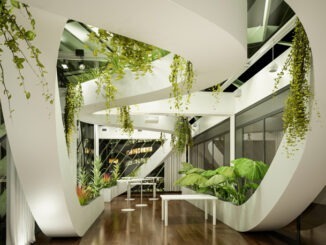
Biophilic design is on the rise in the modern workspace in 2023, but – what benefits does it bring?
Biophilic design incorporates the experience of nature into workplaces and products to foster a ‘human-nature relationship’. It can be incorporated directly by the use of plants, moving water and natural light, or indirectly by mimicking nature through non-natural means which could include images of nature and the use of natural colour schemes.
This is a hot sales trend, so it’s important that dealers consider how they can introduce biophilic design features into their offerings to ensure that customers are receiving products that will help to boost productivity, engage employees and save costs whilst also creating a beautiful workspace – and boosting the dealer’s bottom line.
Features of a biophilic workplace
- Environmental features: plants, vegetation or water displays in workplace designs help to foster human-nature relationships.
- Natural shapes and forms: using complex shapes and forms that mirror natural landscapes and environments, rather than straight edges and harsh lines, mirrors the complexity of the natural world.
- Light and space: making sure that workspaces utilise natural daylight helps those indoors connect with the outside environment. It can help to keep employees on track with their 24-hour cycle and enhance visual comfort, which improves their overall well-being. Natural ventilation can also help to improve air quality.
- Natural materials: materials like bamboo and poplar can be used for furniture and panelling to bring nature into the office.
- Place-based relationships: connecting spaces with the local environment as part of their design can help to build a closer relationship with nature – you can use this relationship to source appropriate plants and other design features.
- Imitative nature: for workplaces where it is not possible to retrofit an existing space, or add natural elements like windows, using designs that mimic nature can also be beneficial. Natural paintings, images and patterns that simulate natural settings can have a similar effect to including actual nature in a design.
Benefits of biophilic design
A biophilic design can benefit your customers across their business, from employee performance and retention to cost savings and reputation. It’s important to really understand the value of a biophilic workspace when you are selling this approach to help you to build a strong sales pitch – emphasise these aspects:
- Productivity: biophilic design can enhance cognitive function by providing access to natural light and views of nature, which can increase productivity and creativity – according to Urban Planters, it can boost productivity by 20%.
- Reduced employee absence: Terrapin Bright Green states that biophilic design can reduce absenteeism by 15%, as natural features encouraged employees to want to spend time in the workplace.
- Improved employee well-being: access to natural elements, such as green spaces, sunlight and fresh air, can help reduce stress, anxiety, and depression.
- Employee retention: biophilic design can create a more pleasant and comfortable work environment which can lead to increased job satisfaction and employee morale – a place where people want to work.
- Better indoor air quality: biophilic design can improve indoor air quality by using natural ventilation reducing the risk of respiratory problems for your workforce.
- Reduced energy consumption: a biophilic workplace design can help reduce energy consumption by using natural light and ventilation, which can lower the need for artificial lighting.
- Brand reputation: biophilic design can contribute to a positive company image by demonstrating a commitment to sustainability and employee well-being.
New research from Ambius has found that almost 40% of UK office workers spend a maximum of just 15 minutes outside, excluding their commute to work. This means that biophilic design is even more important for the modern office, as it can help to bring the outside into a new indoor working environment.


Be the first to comment